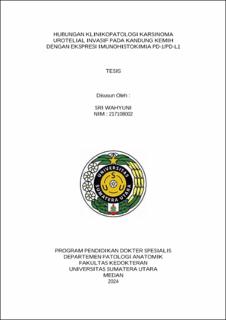| dc.contributor.advisor | Laksmi, Lidya Imelda | |
| dc.contributor.advisor | Mariedina, Causa Trisna | |
| dc.contributor.author | Wahyuni, Sri | |
| dc.date.accessioned | 2025-07-17T07:08:31Z | |
| dc.date.available | 2025-07-17T07:08:31Z | |
| dc.date.issued | 2024 | |
| dc.identifier.uri | https://repositori.usu.ac.id/handle/123456789/105710 | |
| dc.description.abstract | Background: Invasive urothelial carcinoma is a malignant epithelial neoplasm arising from the urothelial lining of the urinary bladder. Urothelial carcinoma is 4 times more commonly in men than women, cause the sixth most common cancer and the ninth cause of death in men. The treatment strategy for urothelial carcinoma depends on non-muscle invasion or muscle invasion. Neo-adjuvant/adjuvant therapy is performed based on the stage of the disease and the presence or absence of metastasis. The adjuvant therapy regimens is immunotherapy programmed cell death-1 protein (PD-1) or its ligand (PD-L1), where this option is preferred for patients who are refractory to chemotherapy regimens.
Objective: To determine clinicopathological features invasive urothelial carcinoma and to analyze the correlation between clinicopathological invasive urothelial carcinoma with PD-1/PD-L1 immunohistochemistry expression.
Methods: This study is an analytical study with a cross-sectional approach, using paraffin blocks from the last 3 years that have been diagnosed as invasive urothelial carcinoma, with 32 samples. Primary PD-1/PD-L1 antibodies use GeneAbTM Monoclonal Rabbit Anti-Human PD-L1 Antibody, 1:100 dilution from the manufacturer GenomeMe which will appear positive and be assessed on the membrane and/or cytoplasm of tumor cells, lymphocytes and macrophages, positive control: tonsils. Calculations using Combine Positive Score (CPS) method.
Results: Invasive urothelial carcinoma was common found in men, age ≥ 60 years, mild TILs and the most subtype of urothelial carcinoma with squamous differentiation.
Conclusion: PD-1/PD-L1 immunohistochemistry expression showed a significant corellation with LVI and was only expressed in the urothelial carcinoma with squamous differentiation subtype. | en_US |
| dc.language.iso | id | en_US |
| dc.publisher | Universitas Sumatera Utara | en_US |
| dc.subject | Urothelial carcinoma | en_US |
| dc.subject | invasive | en_US |
| dc.subject | immunohistochemistry | en_US |
| dc.subject | PD-L1 | en_US |
| dc.title | Hubungan Klinikopatologi Karsinoma Urotelial Invasif pada Kandung Kemih dengan Ekspresi Imunohistokimia PD-1/PD-L1 | en_US |
| dc.title.alternative | Correlation Clinicopathological Invasive Urothelial Carcinoma of Bladder with PD-1/PD-L1 Immunohistochemistry Expression | en_US |
| dc.type | Thesis | en_US |
| dc.identifier.nim | NIM217108002 | |
| dc.identifier.nidn | NIDN0010017604 | |
| dc.identifier.nidn | NIDN0001037904 | |
| dc.identifier.kodeprodi | KODEPRODI11754#Patologi Anatomik | |
| dc.description.pages | 115 Pages | en_US |
| dc.description.type | Tesis Magister | en_US |
| dc.subject.sdgs | SDGs 3. Good Health And Well Being | en_US |


